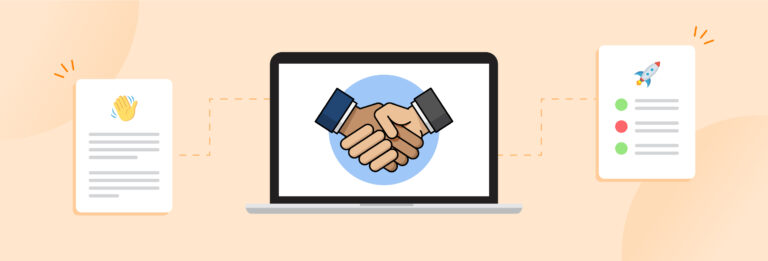The pandemic has disrupted nearly everything and employee onboarding is no exception. When remote working entered the scenario, it brought along what is now known as remote employee onboarding. But that’s not the only way in which this new kind of workplace has impacted employee onboarding. Read on to know all about how disruption has transformed employee onboarding, some of its unique challenges, and remote onboarding best practices.
What is employee onboarding and why does it matter?

Employee onboarding refers to the entire process of bringing onboard a new employee and acquainting them with the company culture and environment. This process often sets the tone for employee experience, as it’s often the first impression that an organization makes on an employee.
The time taken to onboard an employee can differ from company to company. It usually starts from the day of hiring and goes on till the last day of probation, or sometimes till the employee completes a year with the organization. Employee onboarding also encompasses the training and orientation process which helps familiarize the employee with their work and the company culture.
A strong employee onboarding program is not just set in stone and offline; it is dynamic and has the ability to keep up with future disruption. When the times are disruptive, the need is to create an easy, efficient and collaborative onboarding system, one that truly makes the employee feel included.
Here are four statistics to help you understand why employee onboarding is important.
As per Forbes, new hires are 58% more likely to stay with the company for up to 3 years if their onboarding process is good
The Academy of Management Journal states that the first 90 days of hire are crucial as that’s when the employee establishes relationships, understands the work and company culture
Society for Human Resource states that 23% of the new hires who left the job within six months would have stayed longer had they received clearer guidelines about their work
As per The True Cost of Bad Hire, a study by Madeline Laurano, retention improves by 82% if the organizations have a great onboarding process, which includes transforming it during disruptive times
Interested in a report that could give you several more such insights? Read it here.
The 2020 Pandemic and its impact on employee onboarding

The pandemic not only transformed the workplace and our way of working, but also created some unique challenges for the ones creating jobs and hiring. In a scenario where coming to the office was not an option, communication gaps became common and it became increasingly difficult to get work done.
Not every office was armed with a software or tool that could make it easier to get through this disruption. Everyone was dependent on each other and manual procedures were the norm.
The disruption challenged every such norm, causing everyone to pause, introspect and create better options. Read on to know what were some of the many challenges this disruption brought with it.

Communication gap
The biggest issue that came up was a communication gap between various departments. From an environment where one could go up to anyone’s desk and solve an issue within minutes, we were thrown into a system where there was no one way of communication. This led to multiple ways of having conversations, with no set pattern in place.
There was also no one way to communicate the goals of one project or the overall organization, whether for the existing employees or new hires. In the initial phases of remote working, this often led to people being left out of the information loop or, worse still, misinformed.
Disconnect within organizations
As a result of the abovementioned communication gap, an acute disconnect set in within most organizations. New hires and even existing employees could not see each other for months on end and often felt like they were working in isolation as opposed to being part of a team and a company.
This feeling of disconnect had the potential to decrease employee engagement levels within the organization and eventually lead to higher turnover. The management and HR departments also felt this disconnect and that often became evident in the bland onboarding process which several organizations went with in the initial stages of the pandemic.
Lack of progress tracking
Due to the fact that everyone was working remotely, there was no definite way to monitor and measure progress. This impacted the performance measurement and appraisal cycles as the management no more knew how to appraise their teams.
Everyone was working and yet everyone could not be given their performance ratings, because there was no way to judge the moral and ethical codes and to distinguish between individual and collective effort. In the case of new hires, the difficulty went up a notch because these employees had never even met the team and managers in person.
Declining employee experience
All the above factors, combined with the fact that there was no one platform or person to whom the new hires and the old ones could convey their queries or grievances, led to declining employee experience.
The HRs were overwhelmed and so was the administration. The chaos that the disruption of the pandemic brought along was too much to be handled manually. Employees became disengaged and, with the option to speak to them in person now gone, there was nearly no way to re-engage these employees.
Digitalization and the advent of remote employee onboarding

Gradually, most organizations realized the need to go digital and integrate technology to onboard employees successfully in a post-pandemic world. However, adjusting to this change was no easy feat. Here’s a peek into the steps that led to the digitalization of the employee onboarding process and the need to adopt remote onboarding best practices.
Setting up an automated onboarding flow
The first step was to set up an automated onboarding flow and a major part of it was selecting the right onboarding tool. Once organizations were able to do that, they just had to set the procedures in place. The right tool is one that would be able to automate the entire process, from the signing of the contract to the time the probation is completed.
Automation of the FAQ handling process
Given how lost and disconnected the employees and new hires were feeling, resolving their queries quickly and efficiently was one of the top ways to keep them engaged during the pandemic. Also, most of the time these questions were repetitive , especially when they came from the new hires. Hence, an FAQ automation tool, equipped with a conversational and efficient HR chatbot, became the need of the hour. Considering the fact that such chatbots are can store data safely and use it to provide actionable insights, they became the trusted aide of every organization looking to increase productivity and engagement during the pandemic-induced disruption.
Lorem Ipsum is simply dummy text of the printing and typesetting industry. Lorem Ipsum has been the industrys standard dummy text ever since the 1500s, when an unknown printer took a galley of type and scrambled it to make a type specimen book.
Creation and maintenance of a knowledge base
With everyone suddenly shifting to remote working, new hires needed to have a single platform or person they could go to with their queries. Hence, it was essential to go for a conversational HR chatbot that came with the option of a knowledge base. A knowledge base would store all the information that employees and new hires usually need and make it accessible to them at the click of a button. Furthermore, through the use of a chatbot, queries that are beyond the ambit of the knowledge base could easily be transferred to a human executive or a subject matter expert, in turn ensuring employees get the answers they need when they need it.

What are the best practices of remote onboarding?

Since the outbreak of the COVID-19 pandemic, remote work has been the norm. Here are the best practices for onboarding new hires in the post-pandemic workplace:
Have a plan in hand
The HR department should always be ready with a plan and pointers that can be used to build a personalized plan every time a new employee joins the organization. The employee onboarding plan should concentrate on helping new hires settle in and acquaint themselves with the organization, people, and work
Commit to a deadline
When building an employee onboarding plan, it is essential for the HR to put an end date to the employee onboarding process. This helps ensure that the entire training and onboarding process is more efficient and no department delays what they need to do as part of the employee onboarding process.
Monitor the progress
Plans are only good when they bear fruit. Once the onboarding process is done, there should be a monitoring period where the HR notes the strengths and pitfalls and uses these observations to create more efficient onboarding plans in future. This ensures the employee onboarding process keeps evolving and does not become obsolete.
Try group online onboarding
Arranging online group meetings and video conferencing calls with other team members and management while onboarding new hires in the post-pandemic workplace will instill confidence that they can interact with the team whenever required.
Set up an easy virtual training program
You can include live webinar training sessions in your remote onboarding best practices to ensure that new hires ‘questions are answered promptly. Make the coaching as welcoming as possible. Break training programs into steps to make it easier for the fresh recruits to acclimate.
Engage in virtual corporate culture
Building a virtual corporate culture is essential for ensuring successful virtual onboarding. You must ensure that new hires have all supplies (desktop, printer, broadband connection, etc.) to accomplish their job. They must also have access to the managers and higher authorities whenever they require assistance.
Appoint a mentor
While new hires are favoring a post-pandemic hybrid workplace, they are missing important collaborative and social opportunities critical for ensuring productivity and engagement. Providing a virtual mentor to new hires can help them get a good start. While mentoring remote employees is a little different, it can help new employees have a positive and powerful impact.
Wrapping Up
Employee onboarding starts when the employee joins and only ends when they are in sync with the goals of the company and are equipped to work towards these goals independently. This process takes up a considerable part of the time and energy of HRs and investing in software that automates some parts of it might be a good move. If you are wondering where to look for such software, here’s a starting point.







1 Comment